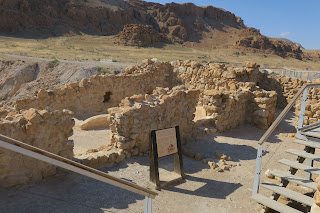Qumran is an archaeological site in the West Bank managed by Israel's Qumran National Park. It is located on a dry marl plateau about 1.5 km (1 mi) from the northwestern shore of the Dead Sea, near the Israeli settlement and kibbutz of Kalya.
The Hellenistic period settlement was constructed during the reign of John Hyrcanus (134–104 BCE) or somewhat later, was occupied most of the time until 68 CE and was destroyed by the Romans possibly as late as 73.
It is best known as the settlement nearest to the Qumran Caves where the Dead Sea Scrolls were hidden, caves in the sheer desert cliffs and beneath, in the marl terrace.
|
Entrance to Qumran. |
|
Ritual Bath.
|
|
Administrator Room. |
|
Ritual Bath.
|
|
Qumran Caves.
|
|
The Dead Sea seen from Qumran. |
See also
Source
Location










